Street photography has always been contentious; plenty of people have objected to it for their various reasons; privacy, the motives behind it, it’s boring, they don’t ‘get it’ and even jealousy.
By its very nature, it necessitates contact with people. Some photographers are happy to stand away from the action with their 400mm lens but for a lot of photographers, myself included, you need to be in close to get to the heart of the situation. Of course, social distancing makes this impossible (or it should do but plenty of people flout the guidelines) but eventually, Covid-19 will have gone and life will return to normal. Or more likely, a new type of normality. It’s hard to say what this new normality will mean for photographers.
There seems to have been a growing backlash and suspicion towards photographers for a while now. Seeking to document real life is not seen as a valid reason. Real-life to many has morphed into filtered selfies and people wanting to control their image. Covid-19 will only increase this suspicion. The reasonable fear of contracting Covid-19 could very likely be transferred to a non-specific fear of others. Already seen as targets for irrational fears photographers could suffer more than most.
There is a supposed increased sense of togetherness in times of crisis and whilst this is true to a certain extent it may possibly be only on a superficial level. We applaud care workers but then break the rules – some of the care workers included. Those stockpiling toilet rolls and basic food items at the start of this pandemic weren’t community-minded. As soon the lockdown is eased we ignore everything we are supposed to have learned, travel around the country dumping our rubbish.
There is an increase in looking after yourself above all else. This is, perhaps, inevitable but this self-preservation instinct can easily become an excuse for isolation, suspicion and resentment.
People need a reason for their fears. To many, seeing a camera is reason enough. Coronavirus (even after it has largely disappeared) will in all probability remain as a weapon against any activity that someone does not agree with.
Different photographers have different ideas of what constitutes street and documentary photography so the situation after this period will be different for different people. Modern street photography seems to concentrate more on the graphic aspect more than the human aspect. If your take on it is to wait in a particular location and take the picture when some tiny figure walks out of the shadows, then nothing much will change. If, however, the photographer wants to convey something about the human condition and the local community then I think it will be much harder in the future.
A lot of my photographs are taken on 28mm or 35mm equivalent lenses, even a lot of the candid ‘street portraits’. Whilst the challenge of keeping the camera unnoticed remains the same it will be keeping yourself unnoticed that will be the bigger problem. I have been able to take many close up pictures of people without them being aware of it, in the main because people aren’t looking for someone taking their photo. If an action is something that you have no preconception of you are far more likely to not notice it. To me, candid photography on the streets is as much about psychology as it is about photography.
After Covid-19, however, people will be more alert. Not specifically with regard to photographers or even the chance of contracting the virus (we’re complacent after all) but I think there will be a long-lasting sense of apprehension about many things. If people are on edge they are more suspicious and defensive. Once we are allowed to get closer to each other I think there is a big chance that people will be reluctant to allow it.
So the challenge will be greater but will still be worthwhile. If we are to document real life, then we have no choice. I think future historians will have a very limited visual record of the present day (especially during the lockdown) despite all the images that are made and shared online. Historians shouldn’t be just looking at what we wanted to be but how we really were.
PS
Does anyone want to swap a 28mm for a 100-400mm?



Good words my friend, like your photography, quality.
Thank you, Iain.